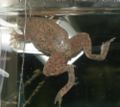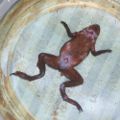Red leg
Contents
What is it[edit]
A serious bacterial disease that amphibians get. It is caused by Saprophytic, gram-negative bacteria such as Aeromonas, Pseudomonas, Proteus, Citrobacter.[1] Though E. coli have also been said to be responsible.[2] . It causes septicemia and open sores on the body.
Symptoms[edit]
In amphibians the flesh turns white and rots away, revealing the deep red layers underneath. This disease often appears at first in the legs (perhaps due to a wound). But can equally appear elsewhere on the body.
Because amphibians often breath through their skin, this disease is especially deadly to them. The bacteria, if not treated, spreads throughout the body quickly and very often causes death in the animal.
Causes[edit]
Thin, newly acquired amphibians that have been maintained in poor-quality water or other inappropriate environmental conditions like poor diet or temperature are particularly susceptible. Clinical signs include lethargy; emaciation; ulcerations of the skin, nose, and toes; and characteristic sores of the legs and abdomen.
- Overeating can cause constipation and therefore bacteria build up in the animal.
Treatment[edit]
Treatment need to done very quickly.
Most gram-negative anti-bacteria treatments will get rid of it. The trouble is getting the drug inside the animal as often it has stopped eating.
- See treatments to get rid of Aeromonas or Pseudomonas bacteria.
Individuals can be treated initially with antibiotics like enrofloxacin (5–10 mg/kg), oxytetracycline (50 mg/kg), or chloramphenicol (50 mg/kg). If fungal infection is suspected, a 0.01% itraconazole bath (5 min daily for 8 days) may be effective.
Though often by the time you notice the infected animal it is often the case it is too late to treat and you may need to consider euthanasia. However these notes may help if you decide to try to save the animal:
- Put the animal in a small quarantine tank asap. With DAFs put it in a minimum level of water to just cover it.
- Perform a 50% water change asap in the main tank and do so again every 2–3 days for 2 weeks to reduce levels of waste in the tank. Check the methods you employ to keep the tank. They may need a rethink.
- A treatment of potassium permanganate may reduce the level of organic material suspended in the main tank water and will therefore help to reduce levels of this bacteria.
- A 1% solution of sea salt in a small quarantine tank will help destroy this bacteria and will minimise electrolyte imbalance in the animal during treatment.
- Lastly treat the animal with an anti-bacteria agent as stated in the above links and try to tempt the animal to eat.
Prevention[edit]
- Feed good quality diet with at least 3 different foods to ensure correct nutrition.
- Regular water changes with monitoring of nitrogen levels to ensure their absent.
- Stress free environment to ensure immune system is working.
- Consider setting up a soil based tank or adding bottled waste bacteria to perform competitive exclusion. See also Walstad.
Special notes[edit]
In the UK there is a virus called the 'Ranavirus'[3][4] that attacks the legs of frogs and toads called commoningly 'Red Leg'.[5]
Pictures[edit]
Links[edit]
- Pollywog on Red Leg
- Xenopus express on Red Leg
- All about Frogs on Red Leg
- Froggie Info on Redleg
- Animal Planet on RedLeg disease
- FluffyFrog on Red Leg
- The Journal of Experimental Medicine - Red leg paper published 1905 by Haven Emerson, M.D. and Charles Norris M.D. (PDF format)
References[edit]
- ↑ The Merck Veterinary Manual - Infectious and Nutritional Diseases: Bacterial Diseases
- ↑ Red Leg infections by All about Frogs web site
- ↑ Ranavirus definition - 1998
- ↑ Ranavirus research Project
- ↑ See page 6 of the PDF paper Amphibian Health & Disease published by Froglife

